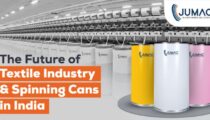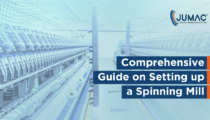Reports by rating firm Infomerics Valuation and Rating predict that…

PLI Scheme for Textile Industry- How It Can Help Spinning Can Industry
There is a definite lack of sync between the trends in the Indian textile and apparel (T&A) industry and those shaping the worldwide fibre sector. While man-made fibres (MMF) is making up nearly 73% of the total consumption of fibres globally – the situation in India is quite the reverse. Over here, MMF constitutes a surprisingly low 40% of the annual fibre consumption levels in India. Leading textile firms and manufacturers of spinning cans have also highlighted poor investments & fund availability, along with stagnancy in export growth, as key problems plaguing the Indian market.
The PLI scheme for the textile industry announced recently, is expected to provide that much-needed boost to reaffirm India’s position as a global powerhouse in this sector. We will here take a quick look at how this scheme will help the spinning can industry:
What Exactly Is The PLI Scheme?
The Indian government recently approved the much-awaited Production Linked Incentive (PLI) scheme. With an overall coverage of 10+ sectors and a total scheme outlay of Rs. 1,45,980 crores, this is easily one of the most noteworthy governmental policies of recent times. As far as the textile industry is concerned, manufacturers of technical textiles and MMF will receive a cumulative incentive of Rs. 10683 crores, over a period of 5 years. The Indian Ministry of Textiles (MoT) has already selected 50 sub-sectors (jerseys, sweaters, tampons, etc.) that will be introduced under the PLI schemes. The incentives given will be based on three different categories.
How Will The PLI Scheme Benefit The Spinning Can Industry?
- Boosting Manufacturing Capacities & Increasing Export Value
Thanks to the PLI scheme, investment and production in the MMF sector in particular, and the sliver can and overall T&A sector in general, will increase manifold. Manufacturers will get the much-needed help in designing quality downstream products on a large scale. The export value of these products is considerably higher. An in-depth look at India’s export share statistics shows that the country does not have a strong position as far as the exports of finished goods & fabrics are concerned. This situation will almost certainly improve with the PLI scheme. Foreign direct investment (FDI) levels will also be boosted, and the benefits will percolate to both brownfield and greenfield investments.
- Helping Companies Achieve Economies Of Scale
At present, many textile manufacturers are suffering from facility size limitations and low production scales. By driving production through key incentives, the PLI scheme is likely to resolve this problem. Since incremental production strategies will be adopted, manufacturers will get ample chances to expand their scope of operations and achieve significant economies of scale. Both large textile manufacturers, as well as MSME players, would be benefited from this scheme. According to industry predictions, the PLI scheme will play a strong role in assisting a smooth V-shaped recovery of the Indian textile industry.
- Bolstering The Productivity and Employment-Generation Capacity Of This Sector
The Indian T&A sector is the second-biggest employment-generating industry in the country (after agriculture). The PLI scheme would provide a further thrust in this regard. Both direct and indirect job openings in the textile industry will go up considerably. Important bottlenecks affecting textile-makers and manufacturers of spinning cans, like exorbitantly priced raw materials, prohibitive tariff barriers, and poor performance in the global MMF textile trade scenario, will be removed. Apart from employment generation, the PLI scheme will also pull up investments, domestic production capacity and productivity levels, and exports. With the PLI scheme in place, there will be more specialisation in the making of MMF products. For leading spinning can manufacturers like Jumac Cans, this scheme definitely comes as good news.
- Bringing About A Paradigm Shift In The Textile Industry
Cotton has by far the biggest share in the total fibre consumption sector in India (northwards of 60%). By boosting MMF, technical textiles and cutting-edge sliver can products, the PLI scheme will be bringing about a radical change. All stages of textile production – right from raw material sourcing/processing to production exporting – will be covered under the scheme. As emphasised by experts, this is a turnover-linked scheme, which will strengthen the presently-poor position of India in the global MMF markets. The demand is already there globally – and the PLI scheme will ensure that Indian exports start picking up.
- Facilitating Innovation and Upgrading The Textile Industry
Most traditional textile manufacturers in India have reached a saturation point in terms of the implementation of new technology. By putting the focus squarely on MMF and technical textiles, more opportunities for technological innovation are expected to open up. That, in turn, will automatically make the Indian textile industry more competitive on the world stage. With the rise in MMF textile exports, positive investor sentiments, and a conducive business environment, the Atma Nirbhar Bharat Mission will also be helped along. For a long time, India has been losing ground to other Asian countries in the T&A export sector. The ambitious PLI scheme will stop the rot and help the country in gaining a better position in this market.
- Boost In Product Quality
While the quantitative benefits of the PLI scheme on MMF production and exports will be huge, the quality of the products would go up as well. Yarn-making processes will become more efficient than before, thanks to the availability of best-in-class sliver can tools and other related manufacturing equipment. In order to ensure that their products do well in global exports, manufacturers will be extra careful about adhering to stringent quality parameters. The biggest challenge will be being able to compete with the MMF textiles manufactured by the more advanced economies. Since there will be no paucity of investments, suppliers will be able to seamlessly implement the latest technologies in their manufacturing processes. It can be reasonably expected that – with the help of the PLI scheme, the Indian textile industry will rise again.
While the benefits of the PLI scheme for the spinning can industry are many, there are a couple of initial points of concern. For starters, the product coverage seems rather limited (with synthetic fibres not under the scheme). Also, the requisite criterion of having to maintain a YoY incremental growth rate of 50% might need to be reviewed. All in all, though, the PLI scheme is a fantastic launchpad to take the Indian textile industry to the next level.
Is this a ‘stitch in time‘? Absolutely!
Recommended Reading: Key Drivers of Global Fibre Market for Textile Industries

Passionate about transforming the industrial sector of textile and spinning industry with innovative solutions. Director at Jumac Manufacturing, leading spinning cans and accessories manufacturer and exporter from Kolkata, India.









